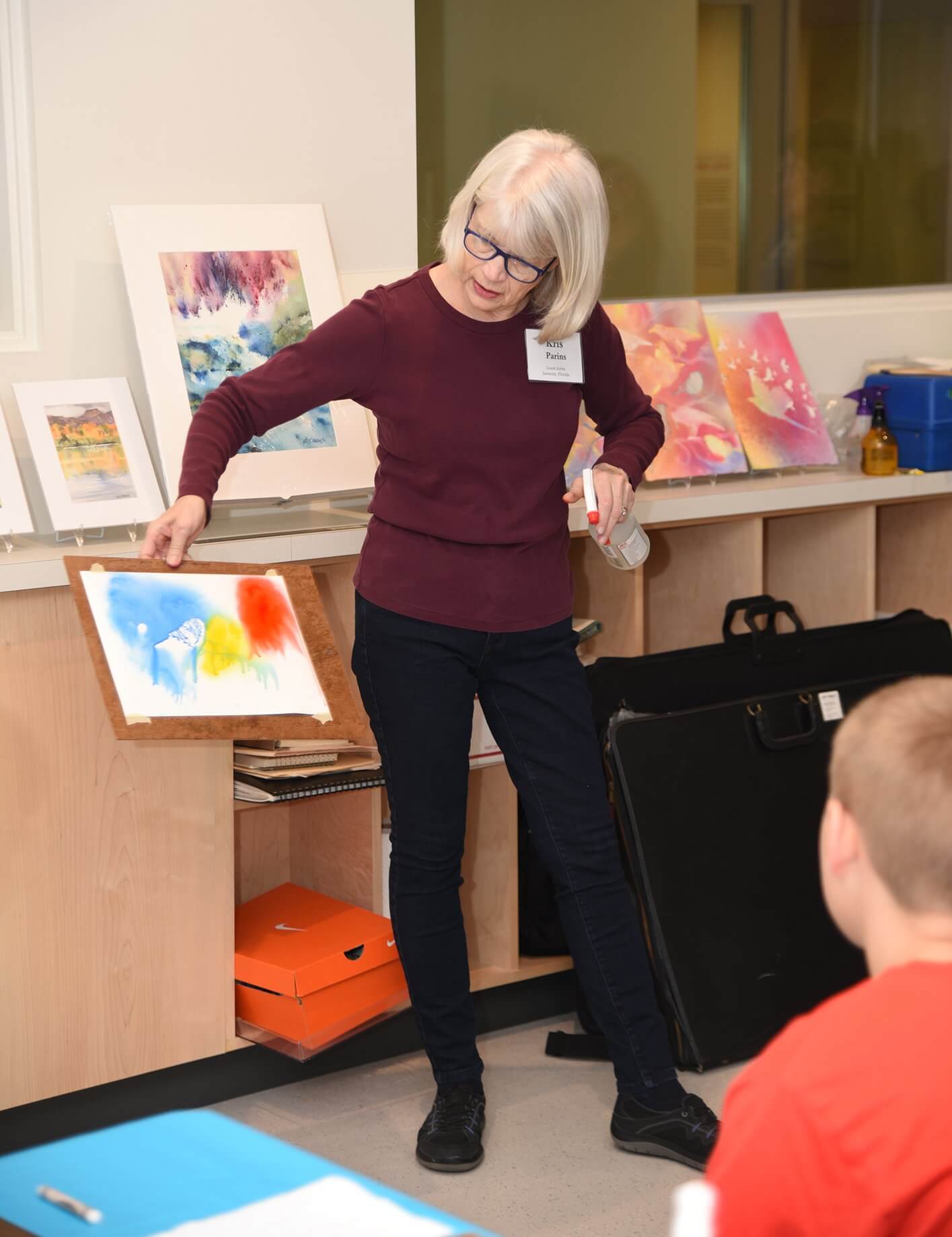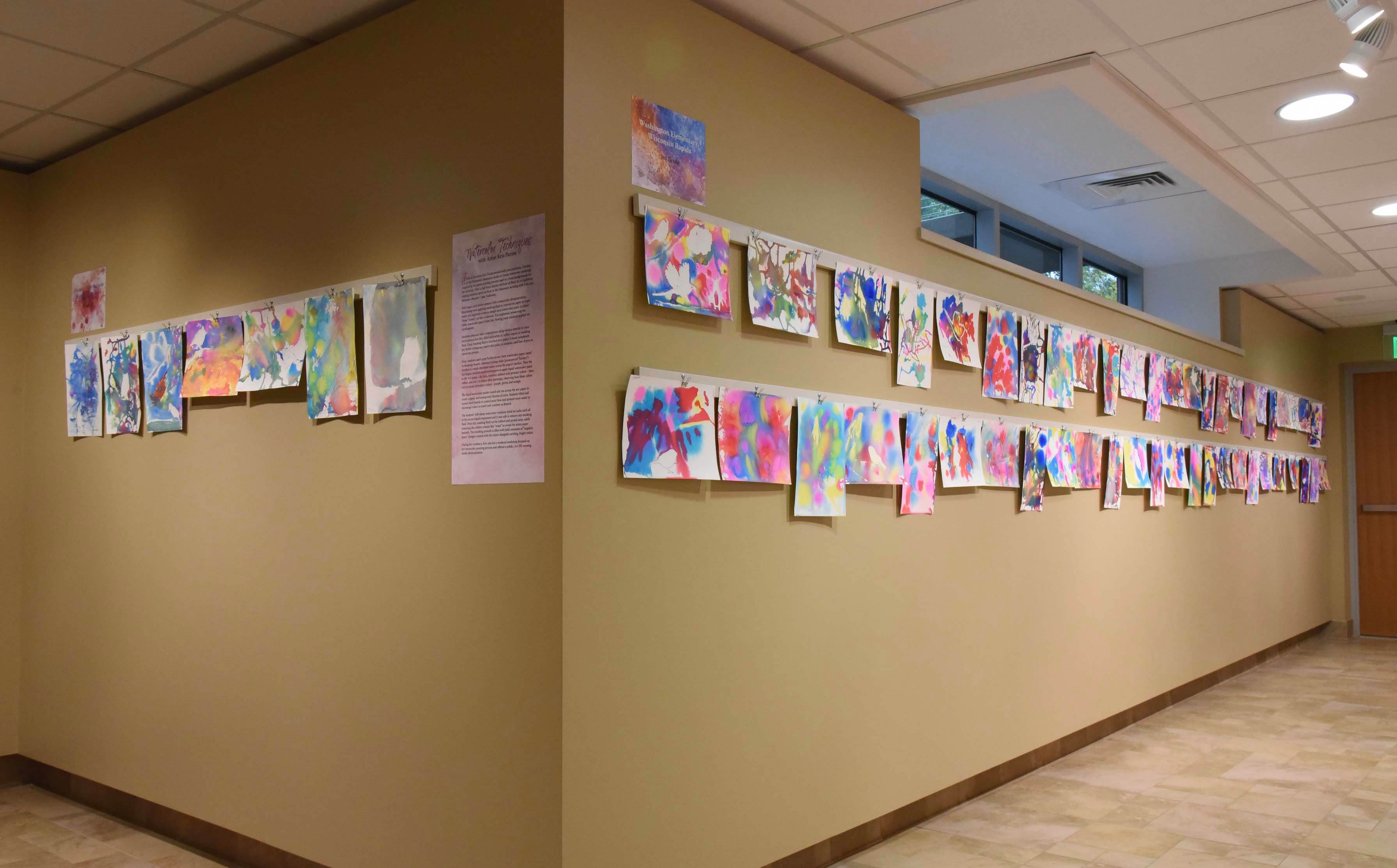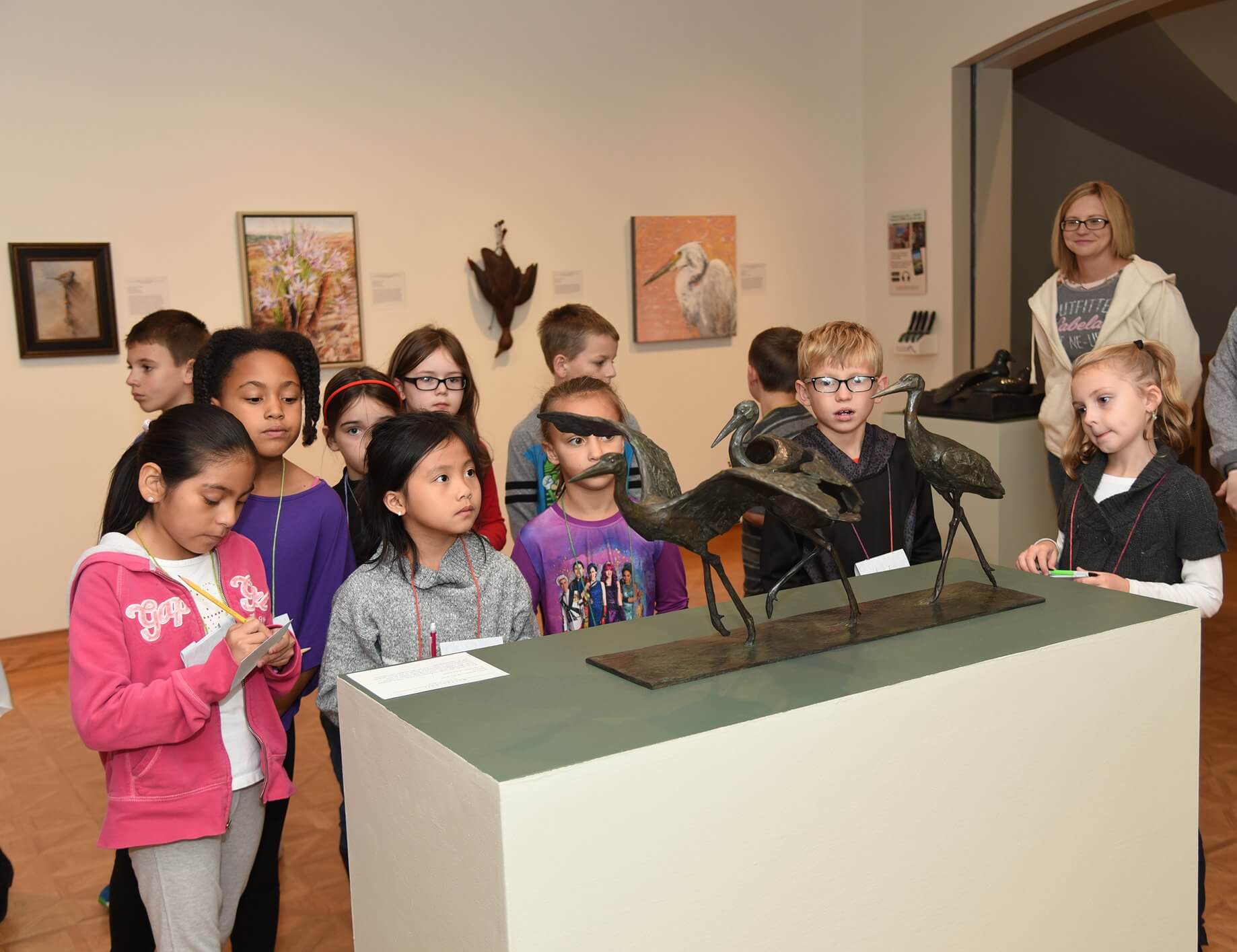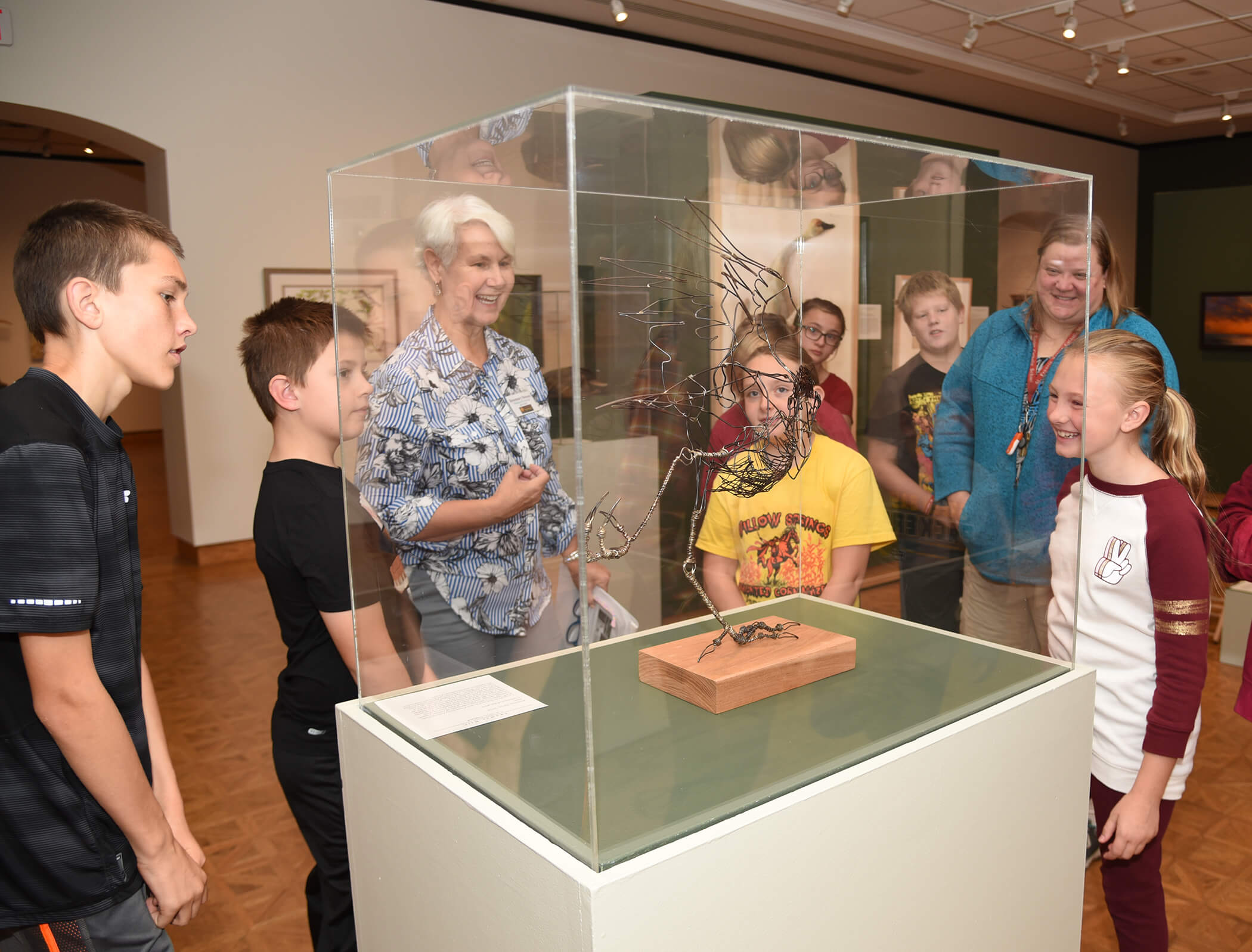 October at the Woodson Art Museum began with Birds in Art artist Kris Parins’ weeklong residency. Kris worked with visiting school groups October 2–5, offered a public demonstration of her watercolor-pouring technique, and led a watercolor workshop in the Museum’s recently renovated classrooms. The addition of natural light in the studio was welcome, and the view of trees outside inspired participants’ work.
October at the Woodson Art Museum began with Birds in Art artist Kris Parins’ weeklong residency. Kris worked with visiting school groups October 2–5, offered a public demonstration of her watercolor-pouring technique, and led a watercolor workshop in the Museum’s recently renovated classrooms. The addition of natural light in the studio was welcome, and the view of trees outside inspired participants’ work.
During their residency visits, students spent a half-hour on a docent-led tour of Birds in Art galleries, followed by an hour in the classroom working with Kris and me to create original watercolors.
Kris began each of the student studio sessions with a demonstration, illustrating how applying masking fluid or crayons on paper to repel water and pigment creates a design once watercolor paint is added. These “resists” act like a raincoat, Kris explained, protecting white watercolor paper from the free-flowing paint students applied via eyedroppers.
Students planned their compositions using various stencils to trace bird outlines they filled with white or yellow crayon or masking fluid. Once masking fluid is brushed onto paper, it must completely dry before adding watercolor paint; students used hair dryers to speed the process.
Next, students used spray bottles to wet their watercolor paper, taped to drawing boards, followed by large hake (pronounced “hockey”) brushes to evenly distribute water across the paper surface.
 Then the real fun began! Students used eyedroppers to apply liquid watercolor paint to the wet paper. Like Kris, students utilized only primary colors – blue, yellow, and red – to create their paintings, observing how these colors mix to create secondary colors – purple, green, and orange.
Then the real fun began! Students used eyedroppers to apply liquid watercolor paint to the wet paper. Like Kris, students utilized only primary colors – blue, yellow, and red – to create their paintings, observing how these colors mix to create secondary colors – purple, green, and orange.
The liquid watercolor paints mixed and ran across the wet paper to create organic and unexpected blooms of color. Students tilted and turned their boards to control paint flow and sprayed more water to encourage colors to travel and combine as desired.
Kris’ watercolor work with students demonstrated how much fun a fluid artmaking process can be, encouraging experimentation and challenging students to embrace the unexpected.

Stop by the Museum to see students’ watercolors on view through Sunday, November 25.
The recent memories of these engaged, curious, and confident students were on my mind last weekend during a trip to Detroit for a daylong session at the Detroit Institute of Arts entitled “The Impact of Art Museum Programs on Students Research Initiative Symposium.” Presented by the National Art Education Association and the Association of Art Museum Directors, this symposium offered art museum educators the opportunity to learn about the results of a three-year, nationwide investigation of the impact of single-visit art museum field trips – directly from the study’s researchers and organizers. This pioneering study marks the first time the effects of facilitated single-visit art museum programs have been measured.
Identifying and understanding the significance of a guided visit to an art museum is crucial in making the case for the role art museums play in student learning. The study measured the effects of a docent-led or museum-educator-led visit on students. The study focused on art museums utilizing an inquiry-based approach rooted in open-ended questions about artwork on view, allowing tour content to develop organically, driven by student observations and interests.
Over 600 students (from Title I schools) in grades four through six and their program facilitators were observed; six art museums participated in the study representing various U.S. regions and populations. To determine the differences between a visit to an art museum with original works of art vs. an inquiry-based program in a school classroom, a separate group of students experienced a classroom program led by an art museum representative.
Research focused on five student capacities: creative thinking, critical thinking, human connections, sensorial and affective responses, and academic connections. Through observation, surveys, and interviews, the study found that a facilitated single-visit art museum program affects students in four ways:
- Students ask more complex questions about works of art.
- Students are more accepting of multiple interpretations of a work of art.
- Students are more likely to think about art in terms of its material properties.
- Students experience greater emotive recall of the visit.
While teaching behaviors in the museum environment were similar to those observed in the classroom, students were more likely to experience teaching techniques that supported creative thinking, human connections, and sensorial/affective responses at the art museum.
 Facilitated art museum visits can provide students with distinct, meaningful learning opportunities that support and exercise vital learning skills, such as creative and critical thinking, curiosity, and empathy. Many symposium attendees echoed the sentiment that the study data supported the intrinsic values of art museum visits regularly observed by program facilitators. The conversations and connections generated by the symposium and study underscore and affirm the importance of the work we do at the Woodson Art Museum and provide further motivation to champion the educational impact of art museum visits.
Facilitated art museum visits can provide students with distinct, meaningful learning opportunities that support and exercise vital learning skills, such as creative and critical thinking, curiosity, and empathy. Many symposium attendees echoed the sentiment that the study data supported the intrinsic values of art museum visits regularly observed by program facilitators. The conversations and connections generated by the symposium and study underscore and affirm the importance of the work we do at the Woodson Art Museum and provide further motivation to champion the educational impact of art museum visits.
 During Woodson Art Museum docent-led visits, students spend time in the galleries observing and conversing about artwork. Volunteer docents introduce students to art on view, using open-ended questions to guide and encourage student responses to what they see and feel while in the presence of original work. Storytelling, tactile aids, movement, and small-group discussions are some of the tools used to help students engage in the galleries; facilitator affirmations of student observations build confidence and support multiple artwork interpretations.
During Woodson Art Museum docent-led visits, students spend time in the galleries observing and conversing about artwork. Volunteer docents introduce students to art on view, using open-ended questions to guide and encourage student responses to what they see and feel while in the presence of original work. Storytelling, tactile aids, movement, and small-group discussions are some of the tools used to help students engage in the galleries; facilitator affirmations of student observations build confidence and support multiple artwork interpretations.
I look forward to sharing more takeaways from the national study with Woodson Art Museum docents and area educators in the coming months. I’d also like to hear from blog readers; what do you most value during art museum visits?




